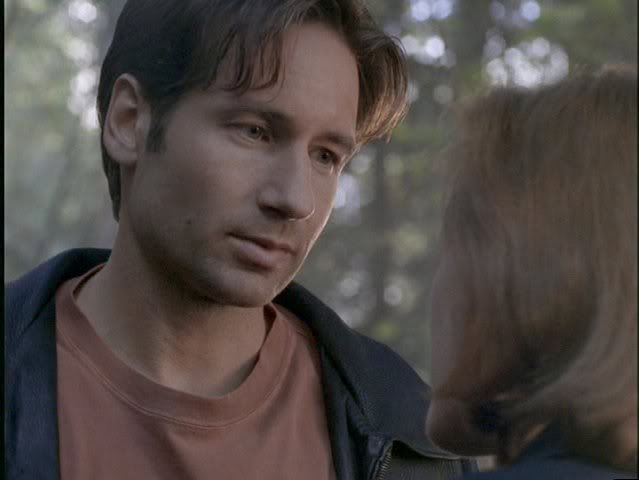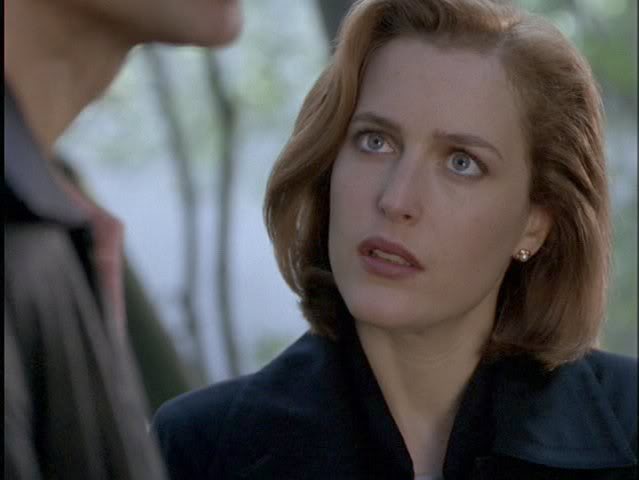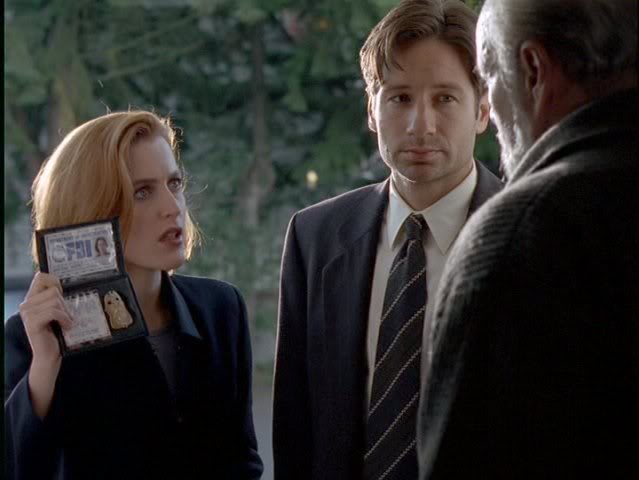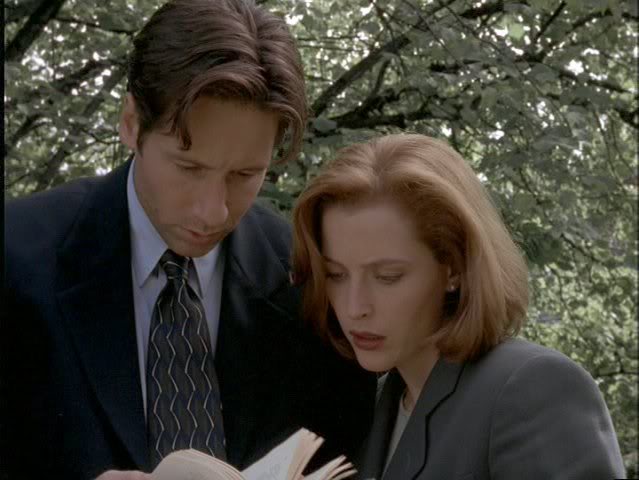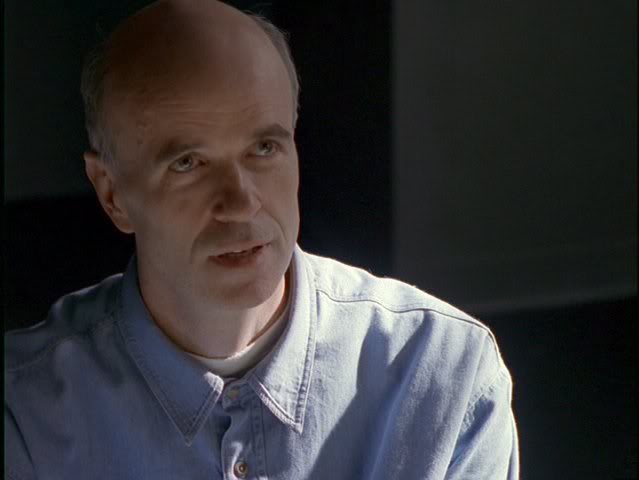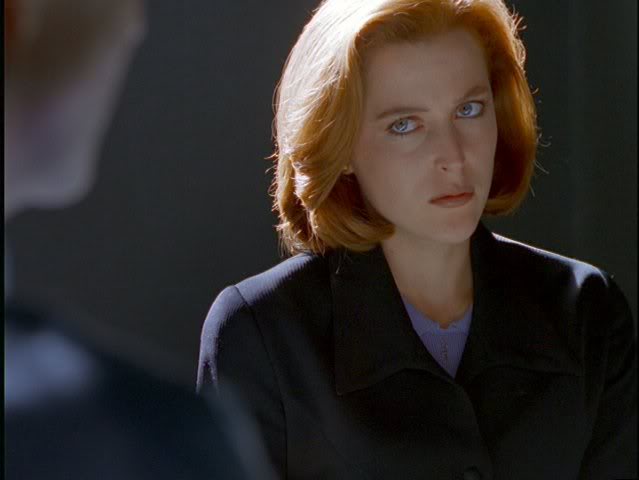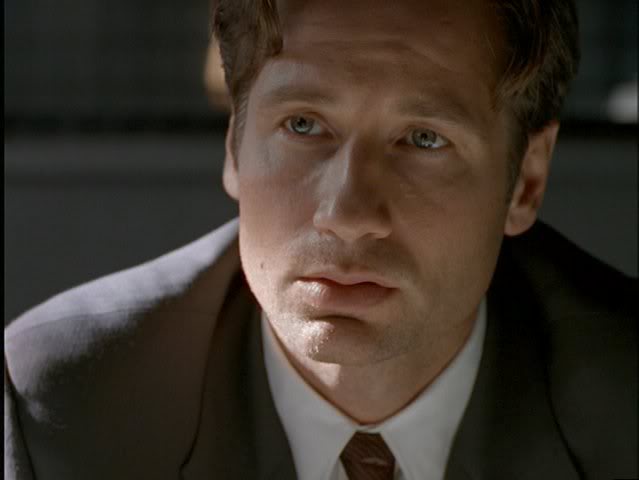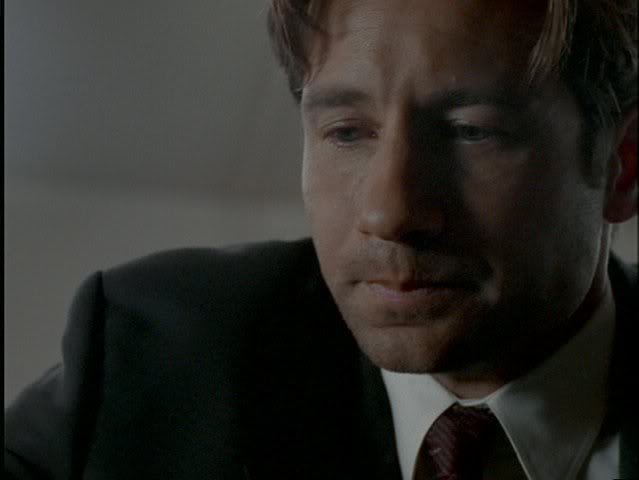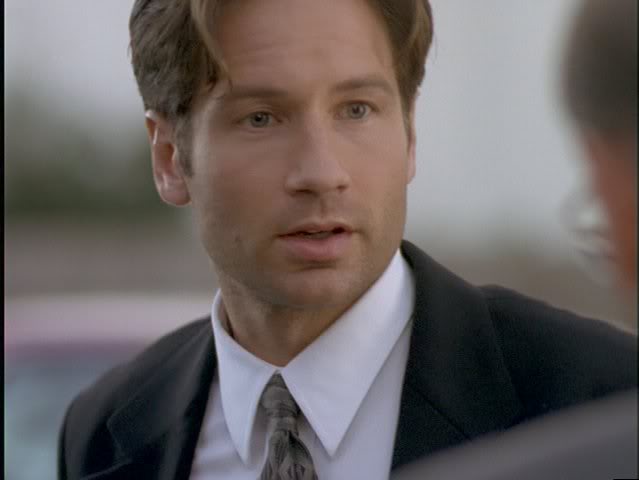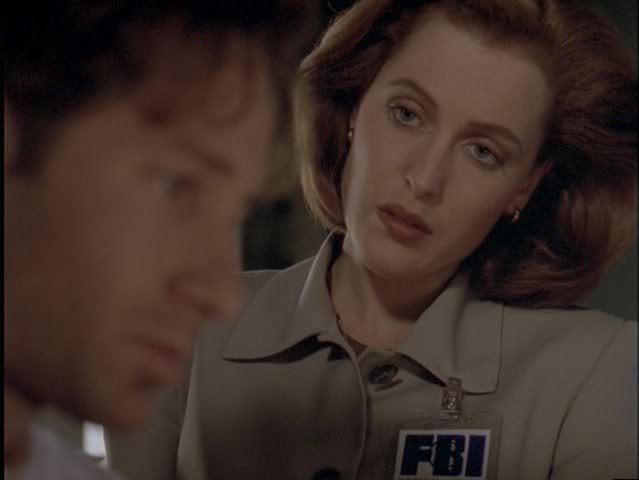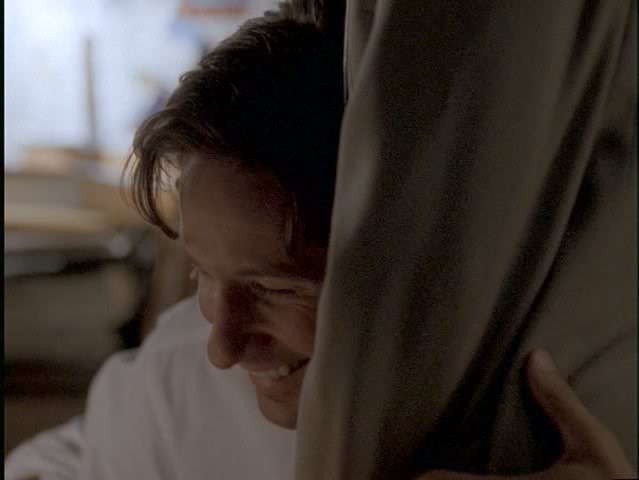CTP Episode of the Day - 12.29.06 - Paper Hearts
I quite purposefully and selfishly kept this one as our next-to-last CTP Episode of the Day. Without question, this is my favorite episode of The X-Files.
Today's Cherished Episode: Paper Hearts (4x08)
Original Air Date: December 15, 1996
Written By: Vince Gilligan
Directed By: Rob BowmanPrompted by a series of prophetic dreams, Mulder reopens the case of a convicted child killer. The murderer claims to know the circumstances of Samantha Mulder's abduction.
"My last dream came true. Scully, do you believe that my sister Samantha was abducted by aliens? Have you ever believed that? No. So what do you think happened to her?"
"What are you saying you believe now?"
"I don't know. I don't know what happened. I don't know what to believe. I just know that I have to find out now."
Some "Paper Hearts" Tidbits & Musings:
-- An episode that might be classified as pseudo-mythological, "Paper Hearts" had elements of both a conventional serial-killer thriller and a quintessential X-Files mind-twister. That it all mixed together surprisingly well was the reason why both Gillian Anderson and David Duchovny, among others, considered it to be one of the best shows of Season 4.
-- Writer and co-producer Vince Gilligan -- who admitted to having "interesting" dreams, but claimed that he never let them affect his writing -- said he came up with the idea for "Paper Hearts" while considering one of the series' longest-running story lines. "Mulder's sister's abduction was the very bedrock, the cornerstone, of the show," he said. "But what if, instead of being attributable to aliens, it was all because of some mundane horror -- like a child killer -- instead? And wouldn't the best way to convince Mulder quickly of this be through a series of prophetic dreams?"
-- Gilligan wanted to include some kind of "fetishistic" killer in his teleplay, but not one who simply mutilated his victims' bodies and dragged home the body parts. "Originally, I had an idea that the killer would take the actual hearts of the victims," Gilligan said. "But I thought about that for five minutes or so and I thought that would be going way too far. It would have been just too gross. No one would want to see that. I wouldn't want to see that." So the writer created John Lee Roche and his penchant for heart-shaped fabric souvenirs.
-- "John Lee Roche was without a doubt the baddest dude I have ever written," said Gilligan. "An evil, evil, black hearted guy, who was a child kidnapper and murderer."
-- Tom Noonan, who played John Lee Roche, was a well-known New York-based actor, screenwriter, playwright, and director. The role was written specifically for him as Gilligan was a fan of Noonan's work.
-- The key to playing Roche, said Noonan, was keeping in mind the one-sided friendship -- for lack of a better word -- between the serial killer and Mulder. "Mulder was Roche's soul mate -- a guy he felt he could really connect with," he said. "When he'd say something about Samantha or his other victims and Mulder would get upset, he'd think, 'What are you upset about? This is our life together.'"
-- "The wonderful thing Tom Noonan did in this episode which was so effective was that he played the role so matter-of-factly," Gilligan said. "He is so wonderfully understated that it literally sends a chill down my spine every time I see this episode."
-- "I came to the show as a fan," recalled Gilligan. "I watched the very first episode at my home in Virginia. At the time I was making a living writing movie scripts. When I was offered a job with the show, I hesitated at first because I didn't want to move to Los Angeles. But I reconsidered and I was glad I did, because it turned out to be the best job I ever had."
-- Gilligan's history as "fan first/writer second" served him well in this episode as he referenced Mulder's earlier profiling days (which were established in the show's pilot), his old mentor Reggie Purdue, Samantha's abduction as shown in "Little Green Men," the wearing of the ankle holster, Mulder's old badge number (as established in "F. Emasculata"), an acknowledgment of Mrs. Mulder's stroke, and having Scully remember something that Mulder once said.
-- When Scully said to Mulder, "A dream is an answer to a question we haven't yet learned how to ask," she was quoting Mulder back at himself. He originally said this to her in Season 2's "Aubrey." Instead of allowing the viewer to think that this episode was a bit like "Aubrey" in a way, Gilligan's reference to the earlier case helped bring home the episode's theme of dreams and nightmares.
--Title: "Paper Hearts" was the nickname given to the case by agents working on it because of the cloth hearts that John Lee Roche removed from his victims' clothing.
-- You always knew you were in for a good time when Mulder and/or Scully appeared in the episode teaser, something that happened less frequently in the early seasons. "Paper Hearts" marked only the fifth time that Mulder appeared in the teaser.
-- The dream-induced laser light that put Mulder on Roche's trail had its origins during Gilligan's years at New York University, when the then film student made extra money working for a company that made laser-illuminated custom holograms; Gilligan learned all he needed to know abut lasers while toiling away in a basement factory and "breathing a lot of xylene fumes." In the final draft of Gilligan's teleplay, Mulder's laser dot was blue, but because of its shorter wavelength, a blue laser was much more expensive and harder to employ than a red one. As the show went into production, the practical choice was made.
-- How did the laser dot morph into written messages to Mulder? The on-set technique tried by David Gauthier and his special effects crew was to project a slide image along the same light path as the laser beam. This proved unsatisfactory. In the end, the same effect was accomplished by the show's L.A.-based visual effects experts, who computer-animated the dot in postproduction.
-- In the real world there is no Bosher's Run Park -- but there is a Bosher's Dam in James River Park, a favorite haunt of Gilligan's in his native Virginia.
-- Roche's Chevy El Camino was obtained in the usual manner; vehicle coordinator Nigel Habgood flagged it down on the street and asked its owner if he'd like to rent his baby to The X-Files.
-- The bright red flames on the sides of the truck in its incarnation as a teenage driver's vehicle were actually decals. After filming was completed, the decals were peeled off and claimed by first assistant director Tom "Frohike" Braidwood who, much to the chagrin of his wife, stuck them onto the front end of his personal Ford Taurus.
-- The trolley bus graveyard really existed. It was in West Vancouver and was discovered by a locations department staff member on a scouting trip during the previous season. Producer Joseph Patrick Finn sent a set of photos of the place to the production office in Los Angeles, and Vince Gilligan wrote the episode's climatic scene specifically for it.
-- Composer Mark Snow, nominated for an Emmy Award for his music for "Paper Hearts," was particularly happy with the Tinkerbell-like motifs that marked the presence of the laser beam. "It was a different kind of texture for the show," he said. "Light, magic, nothing terribly threatening." An inspiration for this theme, he added, was Mendelssohn's "A Midsummer Night's Dream."
-- Snow reported that he had also gotten many requests for a recording of the "Pete Seeger-like folky type of melody" he composed for the show's closing moments. Unfortunately, he said, the piece was only about 30 seconds long -- so there was no point in hanging around your local record store.
-- "Paper Hearts" was the season's eighth episode filmed but the tenth aired. Its completion and airing was postponed in order to free up postproduction resources for "Tunguska" and "Terma." The two-parter had to be finished quickly in order to air during the February sweeps period.
-- David Duchovny had expressed his desire for Mulder to get a chance to shoot some hoops in an X-Files episode (so Duchovny could show off his own basketball skills), and he finally got his wish in "Paper Hearts."
-- To answer the most frequently asked question about this episode, a jump-shooting double was not hired to replace David Duchovny in the shot in the prison gymnasium. "I wasn't there that day," reported Vince Gilligan, "but Rob Bowman told me that David sank that beautiful jump shot on the first try -- nothing but net -- and he stunned the crew into silence." In a total of seven takes of that scene, Duchovny (once a backup guard on the Princeton basketball team) swished four 25-footers.
-- Mulder found Roche's trophy cloth hearts inside a copy of Lewis Carroll's Alice in Wonderland. The red light provided a "Mad Hat" clue, and later, it was noted that Roche had lived on Alice Street. The veiled reference was to Carroll's alleged fascination with prepubescent girls. "Wonderland" was also the last stop on Boston's Blue Line -- the subway that served Revere, Roche's home in 1973.
-- Roche's old car was sold to a man living in Hollyville, Delaware. The city of Hollyville was named for writer Vince Gilligan's significant other, Holly Rice.
-- The dream revisit to the "Little Green Men" abduction scene was one of the definite highlights of the episode, with the adult Mulder dutifully reciting the words and completing the actions as if he were trapped in a play. I love the image that Mulder's office door opened directly to his past; I loved the slight smile as Mulder walked through the door and realized what he was seeing; and I loved the way Duchovny played this scene with such detachment. He didn't want to say the words, but knew that he must.
-- It was more than a little odd that Mulder went to his mother's house unannounced in the middle of the night to rummage around in her basement. Odder still that Mrs. Mulder (who still didn't have a first name at this point) not only kept a 30-year-old vacuum cleaner that she didn't use anymore, but that she also transported it from Martha's Vineyard to her current home in Greenwich, Connecticut. That's a vacuum with sentimental value!
-- The religion question raged on: Mrs. Mulder appeared to have Christmas decorations in her basement storage space.
-- In a strange coincidence, actor Tom Noonan was born in Greenwich, Connecticut.
-- Skinner was wearing his wedding ring again in this episode.
-- The little hug and the hair pet at the end of the episode were nice, but the scene at the Forks of Cacapon, West Virginia, is the great relationship definer for me. Even though she knew it was wrong, that it was not going "by the book," that it could have contaminated a crime scene, and that it could further damage her partner's already fragile emotional state, Scully barely hesitated when Mulder said, "Help me, Scully." She knew what this could mean, she knew they could potentially be digging barehanded in what could have been his sister's grave, but she did it anyway. She stayed by his side and assisted him in what could have been the final step in a quest that was once his alone.
-- After watching the scene with Mulder in the autopsy bay, alone with the body of what might be his sister, I felt sure Duchovny should begin preparing his Emmy speech right then and there. The hesitation as he removed the sheet and prepared himself, then nervously yet hopefully running his fingers lightly over the collarbone, and then the struggle to control a flood of emotions at once (something Duchovny excelled at) when he learned it was not Samantha -- grief, relief, guilt, anger, compassion. "It's somebody though." Mark Snow's score under this scene made it all the more powerful.
-- Oopsie! Mulder reached out to touch the skeleton's collarbone with one hand, but in the close-up it was the opposite hand running fingers along the bone.
-- Speaking of Emmys, Duchovny did receive a 1996-97 Emmy Nomination as Best Actor in a Drama Series, but his nomination was for his work in "Small Potatoes."
-- Director Rob Bowman always filled his episodes with interesting shots and he used the window and Mulder's reflection to great effect in the scene that followed the last interview with Roche as we saw the impact of the interview on all three of the participants. (Plus I'm always a sucker for Reflecting!Mulder!)
-- The dream sequences in the episode fit so well in the flow of the story, never interrupting, only enhancing. The scene in the motel parking lot was a standout, as the unlocking of the car and the release of Samantha paralleled Mulder's unconscious unlocking of Roche's handcuffs and the release of his prisoner.
-- The parking lot scene also offered a glimpse of what Fox Mulder's life might have been like had his sister never been abducted -- there was sheer joy on his face as he embraced his sister representing the return of innocence, love, and happiness that was lost to him when she was taken. A great moment until reality intruded and Mulder was left holding nothing -- awakening to his worst nightmare.
-- The Season 4 DVDs include a deleted scene from the episode which showed how Roche abducted Caitlin.
-- Oopsie! After Mulder was released by Skinner and Scully, he called the airline and was told that Agent Mulder was already given the necessary information, and then he hung up. Oops, I think *he* needed that info as well.
-- Since the episode started with a dream, it was only fitting that it ended with another reference to sleep -- and Mulder being afraid to.
-- "Paper Hearts," like so many other X-Files episodes, left viewers with a lot of questions -- the first of which might have been how did Mulder manage to avoid being fired from his job? (Well, we knew the answer to that one -- he was one of the stars! < g >) But other questions too, like how did Roche know all the details of Samantha's abduction? Did he really form a "nexus" with Mulder, did he find the details on the Internet as Scully suggested, or was he really there? In the case of "Paper Hearts," though, getting those answers didn't seem to matter.
-- It is interesting to watch "Paper Hearts" now in light of what viewers found out about what happened to Samantha. In Season 4, Mulder's biggest dream was to find his sister, to heal himself, and to heal his broken family; finding her body would have been his biggest nightmare and would have put an end to that dream. By Season 7, the quest was weighing so heavily upon Mulder that he wanted to find her body amongst the victims of Ed Truelove -- there was no more family left to heal and he "just wanted it to be over." By Season 7, Mulder was ready to come to the end of the road, to find peace. I love watching "Paper Hearts" anytime, but especially now, knowing that three years later Mulder will find the answers he was looking for (even if many viewers didn't like those answers). And that, surreal or not, he would be reunited with his sister for one brief moment, long enough to understand that her suffering had ceased and that she was in a better place. Long enough to let go; long enough to be set free.
-- Offbeat character actor Tom Noonan started off his career in various theater troupes that utilized his skills as a guitarist and composer. A graduate from Yale's acting school, he founded the Paradise Theatre in 1983, which was instrumental later in his growth as an artist. Gravitating toward film and TV in the 1980s, he began appearing regularly in edgy, unsympathetic roles, most notably as the "Tooth Fairy" serial killer in Manhunter (1986) which was the first feature length film to introduce the infamous Hannibal Lecter character. Most of his other work at this time was solid but unrewarding, including such looming parts in Easy Money (1983), Best Defense (1984), F/X (1986), The Monster Squad (1987), and Robocop 2 (1990), so he began to take classes in writing and directing in order to extend himself.
-- In the 1990s, by appearing in a number of mainstream parts including Last Action Hero (1993), Heat (1995), and The Astronaut's Wife (1999), he was able to finance his own first play-turned-art house film project What Happened Was ... (1994), which became the darling of the Sundance Film Festival that year and won the Grand Jury Prize, not to mention an Independent Spirit nomination. He filmed it in eleven days at a cost of $300,000, and managed to edit it only hours before the Sundance deadline. The success of the two character film, which starred Tom and Karen Sillas as an awkward couple on their first date, induced Tom to finance another film, The Wife (1995), based on his Obie-winning (for writing) play Wifey, which co-starred Tom with Julie Hagerty, Wallace Shawn, and his one-time wife Karen Young. This film, which was warmly received at the Sundance Festival as well, was barely released theatrically, however, as was his third hands-on feature Wang Dang (1999).
-- Noonan had a lead role playing a character named Scully, in the 1989 movie comedy Collision Course.
-- Once & Future Retreads: Rebecca Toolan appeared once again in her recurring role of Mrs. Mulder. Jane Perry (Day Care Operator) was the woman who would file the unexplained cases under the "X's" Dorothy Bahnsen in "Travelers." Vanessa Morley made one of her five appearances as Young Samantha Mulder. Paul Bittante (Local Cop) was Lt. Reagan in "Sleepless" (and was a real-life detective for the Vancouver Police Department). John Dadey (Local Agent) was a U.S. Marshall in "Kitsunegari." Jenny-Lynn Hutcheson (Addie Sparks) was the Little Girl from Trailer in "F. Emasculata" and Polly Turner in "Chinga."
-- "Paper Hearts" is my favorite episode because to me it is the "perfect" X-File. IMBO, it has it all -- part mytharc, part monster-of-the-week. It's got Samantha!Abduction, Mulder!Angst, Mulder!Torture, Scully!Angst, Scully!Comfort, Strong!Skinner, continuity up the wazoo, and Mulder!Glasses (for the shallow part of us all < g >). It's got great acting by all concerned, a great story that grabs you in the teaser and doesn't let go, great writing by the writer who I think wrote the Mulder/Scully partnership the best, great directing by Rob Bowman, fantastic music by Mark Snow, and a creepy villain that confirms that real people are often the scariest monsters.
-- Lastly, the best X-Files -- especially the best monster-of-the-week episodes -- were those that involved our heroes personally in some way (think "Irresistible," "Oubliette," "Grotesque," "Unruhe," etc.). You couldn't get much more personal than the abduction of Samantha Mulder. Everyone has their favorites; the episodes in my own personal top ten change from time to time. But this episode never waivers from its spot at the top of my list. For me, "Paper Hearts" is The X-Files' finest hour.
(Thanks to chrisnu for today's pics.)
And with that, we're done with our CTP discussions for Season 4. That leaves only one more season unfinished -- only one more episode to go and we're all done. So we'll end the old year and ring in the new one with our final CTP Episode of the Day -- "The Truth."
Please share your first impressions, favorite (or cringe-worthy) moments, classic lines, favorite fanfic, nagging questions, repeated viewing observations, etc., as today we celebrate "Paper Hearts."
Polly
